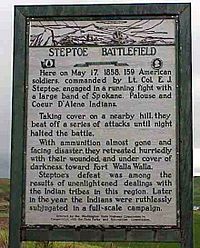Battle of Pine Creek facts for kids
Quick facts for kids Battle of Pine Creek (Battle of Tohotonimme) |
|||||||
|---|---|---|---|---|---|---|---|
| Part of The Coeur d'Alene War, Yakima War | |||||||
 Monument to the Battle of Pine Creek in Rosalia, Washington |
|||||||
|
|||||||
| Belligerents | |||||||
| United States of America | Coeur D' Alenes Yakama, Cayuse, Spokane, possibly Walla Walla Indians, assorted Native American tribes | ||||||
| Commanders and leaders | |||||||
| Bvt. Lt. Col. Edward Steptoe | Kamiakin, et al. | ||||||
| Strength | |||||||
| 164 riflemen | 800-1,000 (est.) | ||||||
| Casualties and losses | |||||||
| 19 dead 27+ wounded (est.) | 9 dead (est.); 40+ wounded | ||||||
The Battle of Pine Creek was a fight between the United States Army and several Native American tribes. It is also known as the Battle of Tohotonimme or the Steptoe Disaster. The battle happened on May 17, 1858. It took place near what is now Rosalia, Washington.
The U.S. Army forces were led by Edward Steptoe, a Lieutenant Colonel. They fought against members of the Coeur d'Alene, Palouse, and Spokane tribes. The Native American tribes won this battle.
Why the Battle Happened
Tensions had been growing in the Columbia Plateau area. This started after the 1855 Walla Walla Council. During this meeting, tribes were made to give up large parts of their land. Many tribal leaders, like Yakama chief Kamiakin, did not agree with these treaties.
Miners also entered tribal lands without permission. They sometimes attacked Native Americans. Some tribes fought back, leading to isolated killings of white settlers. In late 1855, the Oregon militia attacked. This led to the Battle of Walla Walla and the death of Walla Walla chief Peopeomoxmox.
Rumors also spread that a military road would be built across tribal lands. This made the tribes in the area even angrier. In 1858, some Palouse people killed two miners. This was to get revenge for wrongs done to their people. White settlers living at Fort Colvile then asked Steptoe for military help.
Steptoe left Fort Walla Walla on May 6, 1858. His main goal was to investigate the miners' deaths. He also wanted to show a military presence. This was to calm the white settlers who were moving onto Native American lands. Steptoe also hoped to get back some cattle taken by the Palouse.
Steptoe's group had 159 soldiers. Each soldier had about 40 rounds of ammunition. They also carried two small cannons called mountain howitzers. When Steptoe crossed the Snake River, he entered Spokane land. This went against a promise made by Governor Isaac Stevens. Stevens had said that white people would respect Spokane land if the tribe stayed peaceful.
The Battle Begins
On May 15, Steptoe set up camp on a hill. It was south of Rosalia, Washington, in Coeur d'Alene territory. The next day, some tribal leaders met Steptoe. They wanted to know why he was on their land. Steptoe explained he wanted to solve problems between miners and tribes near Fort Colvile. He also asked for help to cross the Spokane River, which was high from melting snow. The tribes refused to help.
On the morning of May 17, Steptoe decided to turn back. He led his troops near where Spring Valley Creek and North Pine Creek meet. At this point, a group of Coeur d'Alenes attacked. Some Palouses joined them. A long battle followed, lasting about ten hours. More warriors joined the fight. Soon, Steptoe's small force was attacked by over a thousand Palouse, Spokane, and Coeur d'Alene warriors.
By early afternoon, Steptoe's men were defending themselves from a hill. It overlooked Pine Creek from the east. The Native American warriors stopped fighting for the night. They planned to finish the battle the next morning. However, they did not know that Steptoe's soldiers had very little ammunition left. Each man had only about three rounds.
Under the cover of darkness and heavy rain, Steptoe made a plan. He left behind his supplies and cannons. Then, he led his soldiers through the enemy lines. They escaped without being noticed and headed back to Fort Walla Walla.
What Happened Next
After the battle, Jesuits from the nearby Sacred Heart Mission went to Fort Vancouver. They hoped to arrange a peace agreement. Steptoe's commanding officer, General Newman S. Clarke, had strong demands. He wanted all warriors who fought in the battle to surrender. He also demanded that all captured property be returned.
Clarke also wanted Yakama chief Kamiakin to be sent away from the region. His toughest demand was that the Coeur d'Alenes allow a military road to be built through their land. This road was called the Mullan Road.
The tribal leaders did not accept Clarke's terms. Some, like Spokane Garry, wanted peace. But they refused to give up their neighbors. Other leaders did not want peace at all. In August 1858, General Clarke sent Colonel George Wright with 500 soldiers.
Wright's forces defeated the allied tribes at the Battle of Four Lakes. Three days later, Wright won another victory at the Battle of Spokane Plains. The tribes' resistance was broken. They were forced to sign new treaties. They also had to move to special areas called reservations. Within ten years, the Mullan Road was finished. Thousands of miners and settlers then moved into the region.]

